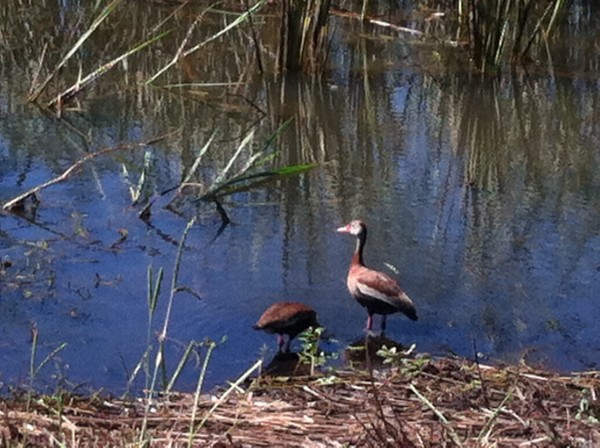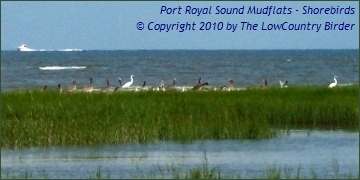Black-Bellied Whistling Ducks at Savannah NWR
July 10, 2012LCB
With the re-opening of the Savannah National Wildlife Refuge early this year, our family took a ride out to see the new water-management gates and the resulting changes in the refuge. I have to say that the most impressive area now is about half-way along the refuge drive where there are now shallow lakes and wetlands where before it was more of a group of wet fields.
Especially exciting was the presence of Black-Bellied Whistling Ducks there by the dozens! Many photographers were out getting excellent pictures of nearby ducks with their bright red bills, who normally range up into Texas from Mexico but have somehow found their way to the Lowcountry! I didn’t have my best camera along, but here is a shot of a pair of the ducks, who must be nesting at this time of the year.

Fall Egret Convention in My Back Yard
October 6, 2010LCB
It happens every October or November: a bunch of egrets and cormorants will congregate along the lagoon in our back yard, usually in the late afternoon or evening. They don’t seem to be hunting for food – just getting together to “hang out” in the branches of the trees and shrubs along the lagoon.
I don’t see this behavior at other times of the year other than around a “rookery” – any ideas as to why they do this? Since we live near Hilton Head, I don’t think they’re flocking together to migrate somewhere else since I’ll see them all winter around our area as well as now.
Here’s a video of them from last fall – and I see more of them coming in to our lagoon today!
Wood Storks in My Backyard
August 2, 2010LCB
I saw a recent article in a Charleston newspaper proclaiming: “Wood Storks Stage Comeback.” Apparently there are now over 150 breeding pairs in the Dungannon Plantation Heritage Preserve about 10 miles south of Charleston. Now there are 40 pairs of Wood Storks that have established what may be the largest urban breeding colony in the region in Dill Sanctuary, on the Stono River on James Island, five miles from downtown Charleston. Here’s a snippet from the article (which is no longer available online):
Incongruously, up close on the ground, the stork’s wrinkly head might be uglier than the macabre vulture it’s related to.
“It’s not a handsome bird,” said Andy Harrison, a member of Charleston Audubon.
Like the bald eagle, the stork has become a bellwether of the potential of preserving coastal environment as the Lowcountry develops. Its success gives conservationists hope for the return of fabled wildlife such as the whooping crane lost more than a century ago.
A generation ago, the stork bird had all but disappeared. An estimated 40,000 breeding pairs in the Southeast in 1930 were decimated by the loss of their nesting habitat and shallow feeding waters. In 1981, only 11 pairs were counted in South Carolina.
But recent counts put the number of wood stork pairs in the state at more than 2,000, the largest colony in the United States.
I feel fortunate to have had several of these magnificent (but admittedly UGLY!) birds visit our back yard over the past year. Here is a picture I took from my office window of two of them that were having some “quality time” on the bank of the lagoon behind our house: (Read more…)
Marbled Godwit and Gulls on Hilton Head Island
July 18, 2010LCB
I took this video of a Marbled Godwit along the shore of Port Royal Sound during spring migration this year. We were at Mitchellville Beach Park on the north end of Hilton Head Island and saw a lot of migrating shorebirds that day – this is a real birding hotspot during spring and fall migration!
I was using a small hand-held digital camera and it was a windy day, so the audio has some wind noise and the picture is a bit unsteady at times since the wind was blowing me around. But I think it still provides a great closup look at a Marbled Godwit feeding along the shallows of the Port Royal Mud Flats.
Turtles Stage World Cup – “Fishball 2010”
July 12, 2010LCB
While the eyes of the world were on the World Cup final game in South Africa, the Yelllow-bellied Slider turtles in the lagoon behind my home staged their own version of the “World Cup” by pushing around a dead fish floating on the surface. Welcome to all the exciting action of “Fishball 2010”!
G-A-A-O-O-O-O-O-L-L-L!!!!

